Overview
- Description
- Photographic portrait with handwritten caption reading "Rose."
- Credit Line
- United States Holocaust Memorial Museum Collection, Gift of Lynda Cohen
Physical Details
- Genre/Form
- Photograph.
- Extent
-
1 folder
Rights & Restrictions
- Conditions on Access
- There are no known restrictions on access to this material.
- Conditions on Use
- Material(s) in this collection may be protected by copyright and/or related rights. You do not require further permission from the Museum to use this material. The user is solely responsible for making a determination as to if and how the material may be used.
Administrative Notes
- Holder of Originals
-
United States Holocaust Memorial Museum
- Legal Status
- Permanent Collection
- Provenance
- Donated to the United States Holocaust Memorial Museum in 2017 by Lynda Cohen, daughter of Sara Kupinski Cohen.
- Record last modified:
- 2023-02-24 14:31:56
- This page:
- https://collections.ushmm.org/search/catalog/irn564918
Download & Licensing
- In Copyright - Use Permitted
- Terms of Use
- This record is not digitized and cannot be downloaded online.
In-Person Research
- Request 7 Days in Advance of Visit
- Plan a Research Visit
-
Request in Shapell Center Reading Room
Bowie, MD
Contact Us
Also in Sara Kupinski Cohen collection
The collection consists of a kimono, shoes, a vase, decorative silver figurines, a novelty card, and a photograph relating to the experiences of Sara Kupinski Cohen and her family in Poland and Lithuania, before and during the Holocaust, in the Soviet Union, Japan, and China during the Holocaust, and in Canada after the war.
Date: approximately 1920-1947
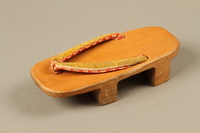
Pair of Japanese geta owned by a Lithuanian Jewish refugee in the Shanghai Ghetto
Object
Pair of wooden geta with fabric thongs acquired by Sara Kupinski’s (later Cohen) family in Kobe, Japan, where her family fled using Japanese and Dutch transit visas supplied by diplomats in Soviet-occupied Kovno, (Kaunas), Lithuania. Sara lived outside of Lida, Poland (now Belarus) with her parents, Eliasz and Slawa, brother, Hirsz, and uncle, Samuel. Following Germany and the Soviet Union’s invasion of Poland in September 1939, Eli and Samuel fled to Vilna (now Vilnius, Lithuania) because they were considered wealthy landowners. Slawa, Hirsz, and Sara later joined them. Having obtained their transit visas in August 1940, Sara’s family left later that year, traveling on the Trans-Siberian railway from Moscow to Vladivostock. In early 1941, they took a boat to Kobe, Japan. That fall, they were forced to go to Japanese-controlled Shanghai. Samuel and Eli found work at a Jewish import and export company, and Sara and Hirsz attended the Jewish school. In early 1943, Japanese authorities ordered that all stateless refugees must live within a designated area, which came to be known as the Shanghai or Hongkew ghetto. In the summer of 1945, following the German surrender in May, US forces bombed Shanghai heavily. On August 14, Japan surrendered to the US. The Kupinski family learned that Slawa’s brothers had survived in France, but that her parents were killed in the Vilna ghetto in 1942 or 1943. Eli’s parents likely died in Siberia. In 1949, the family settled in Toronto, Canada.
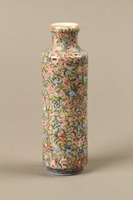
Enameled porcelain vase with a floral pattern owned by Lithuanian Jewish refugee in the Shanghai Ghetto
Object
Colorful, enameled, porcelain vase acquired by Sara Kupinski’s (later Cohen) family in Shanghai, China, where her family fled using Japanese and Dutch transit visas supplied by diplomats in Soviet-occupied Kovno, (Kaunas), Lithuania. Sara lived outside of Lida, Poland (now Belarus) with her parents, Eliasz and Slawa, brother, Hirsz, and uncle, Samuel. Following Germany and the Soviet Union’s invasion of Poland in September 1939, Eli and Samuel fled to Vilna (now Vilnius, Lithuania) because they were considered wealthy landowners. Slawa, Hirsz, and Sara later joined them. Having obtained their transit visas in August 1940, Sara’s family left later that year, traveling on the Trans-Siberian railway from Moscow to Vladivostock. In early 1941, they took a boat to Kobe, Japan. That fall, they were forced to go to Japanese-controlled Shanghai. Samuel and Eli found work at a Jewish import and export company, and Sara and Hirsz attended the Jewish school. In early 1943, Japanese authorities ordered that all stateless refugees must live within a designated area, which came to be known as the Shanghai or Hongkew ghetto. In the summer of 1945, following the German surrender in May, US forces bombed Shanghai heavily. On August 14, Japan surrendered to the US. The Kupinski family learned that Slawa’s brothers had survived in France, but that her parents were killed in the Vilna ghetto in 1942 or 1943. Eli’s parents likely died in Siberia. In 1949, the family settled in Toronto, Canada.
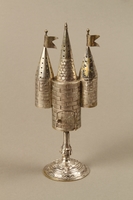
Castle-shaped Havdalah spice box (besamim) owned by a Lithuanian Jewish refugee in the Shanghai Ghetto
Object
Silver alloy, castle-shaped spice box from Poland, carried by Sara Kupinski’s (later Cohen) family as they traveled through the Soviet Union and Japan to China, where her family fled using Japanese and Dutch transit visas supplied by diplomats in Soviet-occupied Kovno, (Kaunas), Lithuania. Later, the box was given to Sara by her mother, Slawa, as a wedding gift in Canada, where the family had settled in 1949. Sara lived outside of Lida, Poland (now Belarus) with her parents, Eliasz and Slawa, brother, Hirsz, and uncle, Samuel. Following Germany and the Soviet Union’s invasion of Poland in September 1939, Eli and Samuel fled to Vilna (now Vilnius, Lithuania) because they were considered wealthy landowners. Slawa, Hirsz, and Sara later joined them. Having obtained their transit visas in August 1940, Sara’s family left later that year, traveling on the Trans-Siberian railway from Moscow to Vladivostock. In early 1941, they took a boat to Kobe, Japan. That fall, they were forced to go to Japanese-controlled Shanghai. Samuel and Eli found work at a Jewish import and export company, and Sara and Hirsz attended the Jewish school. In early 1943, Japanese authorities ordered that all stateless refugees must live within a designated area, which came to be known as the Shanghai or Hongkew ghetto. In the summer of 1945, following the German surrender in May, US forces bombed Shanghai heavily. On August 14, Japan surrendered to the US. The Kupinski family learned that Slawa’s brothers had survived in France, but that her parents were killed in the Vilna ghetto in 1942 or 1943. Eli’s parents likely died in Siberia.
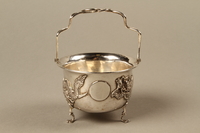
Silver bowl with a dragon owned by a Lithuanian Jewish refugee in the Shanghai Ghetto
Object
Decorative, Zee Sung Silver bowl acquired by Sara Kupinski’s (later Cohen) family in Shanghai, China, where her family fled using Japanese and Dutch transit visas supplied by diplomats in Soviet-occupied Kovno, (Kaunas), Lithuania. Sara lived outside of Lida, Poland (now Belarus) with her parents, Eliasz and Slawa, brother, Hirsz, and uncle, Samuel. Following Germany and the Soviet Union’s invasion of Poland in September 1939, Eli and Samuel fled to Vilna (now Vilnius, Lithuania) because they were considered wealthy landowners. Slawa, Hirsz, and Sara later joined them. Having obtained their transit visas in August 1940, Sara’s family left later that year, traveling on the Trans-Siberian railway from Moscow to Vladivostock. In early 1941, they took a boat to Kobe, Japan. That fall, they were forced to go to Japanese-controlled Shanghai. Samuel and Eli found work at a Jewish import and export company, and Sara and Hirsz attended the Jewish school. In early 1943, Japanese authorities ordered that all stateless refugees must live within a designated area, which came to be known as the Shanghai or Hongkew ghetto. In the summer of 1945, following the German surrender in May, US forces bombed Shanghai heavily. On August 14, Japan surrendered to the US. The Kupinski family learned that Slawa’s brothers had survived in France, but that her parents were killed in the Vilna ghetto in 1942 or 1943. Eli’s parents likely died in Siberia. In 1949, the family settled in Toronto, Canada.
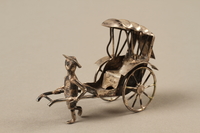
Silver rickshaw and driver figurine owned by a Lithuanian Jewish refugee in the Shanghai Ghetto
Object
Silver rickshaw and runner figurine acquired by Sara Kupinski’s (later Cohen) family in Shanghai, China, where her family fled using Japanese and Dutch transit visas supplied by diplomats in Soviet-occupied Kovno, (Kaunas), Lithuania. Sara lived outside of Lida, Poland (now Belarus) with her parents, Eliasz and Slawa, brother, Hirsz, and uncle, Samuel. Following Germany and the Soviet Union’s invasion of Poland in September 1939, Eli and Samuel fled to Vilna (now Vilnius, Lithuania) because they were considered wealthy landowners. Slawa, Hirsz, and Sara later joined them. Having obtained their transit visas in August 1940, Sara’s family left later that year, traveling on the Trans-Siberian railway from Moscow to Vladivostock. In early 1941, they took a boat to Kobe, Japan. That fall, they were forced to go to Japanese-controlled Shanghai. Samuel and Eli found work at a Jewish import and export company, and Sara and Hirsz attended the Jewish school. In early 1943, Japanese authorities ordered that all stateless refugees must live within a designated area, which came to be known as the Shanghai or Hongkew ghetto. In the summer of 1945, following the German surrender in May, US forces bombed Shanghai heavily. On August 14, Japan surrendered to the US. The Kupinski family learned that Slawa’s brothers had survived in France, but that her parents were killed in the Vilna ghetto in 1942 or 1943. Eli’s parents likely died in Siberia. In 1949, the family settled in Toronto, Canada.
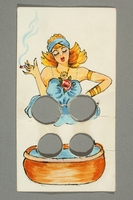
Illustrated postcard with finger holes owned by a Lithuanian Jewish refugee in the Shanghai Ghetto
Object
Hand-illustrated card carried by Sara Kupinski’s (later Cohen) family as they fled from Poland, via Lithuania, the Soviet Union, Japan, and China, during the Holocaust, eventually settling in Canada. They were able to flee by using Japanese and Dutch transit visas supplied by diplomats in Soviet-occupied Kovno (Kaunas), Lithuania. Sara lived outside of Lida, Poland (now Belarus) with her parents, Eliasz and Slawa, brother, Hirsz, and uncle, Samuel. Following Germany and the Soviet Union’s invasion of Poland in September 1939, Eli and Samuel fled to Vilna (now Vilnius, Lithuania) because they were considered wealthy landowners. Slawa, Hirsz, and Sara later joined them. Having obtained their transit visas in August 1940, Sara’s family left later that year, traveling on the Trans-Siberian railway from Moscow to Vladivostock. In early 1941, they took a boat to Kobe, Japan. That fall, they were forced to go to Japanese-controlled Shanghai. Samuel and Eli found work at a Jewish import and export company, and Sara and Hirsz attended the Jewish school. In early 1943, Japanese authorities ordered that all stateless refugees must live within a designated area, which came to be known as the Shanghai or Hongkew ghetto. In the summer of 1945, following the German surrender in May, US forces bombed Shanghai heavily. On August 14, Japan surrendered to the US. The Kupinski family learned that Slawa’s brothers had survived in France, but that her parents were killed in the Vilna ghetto in 1942 or 1943. Eli’s parents likely died in Siberia. In 1949, the family settled in Toronto, Canada.
Formal, patterned kimono and shibori obi owned by a Lithuanian Jewish refugee in the Shanghai Ghetto
Object
Patterned kimono and obi acquired by Sara Kupinski’s (later Cohen) family in Kobe, Japan, where her family fled using Japanese and Dutch transit visas supplied by diplomats in Soviet-occupied Kovno, (Kaunas), Lithuania. Sara lived outside of Lida, Poland (now Belarus) with her parents, Eliasz and Slawa, brother, Hirsz, and uncle, Samuel. Following Germany and the Soviet Union’s invasion of Poland in September 1939, Eli and Samuel fled to Vilna (now Vilnius, Lithuania) because they were considered wealthy landowners. Slawa, Hirsz, and Sara later joined them. Having obtained their transit visas in August 1940, Sara’s family left later that year, traveling on the Trans-Siberian railway from Moscow to Vladivostock. In early 1941, they took a boat to Kobe, Japan. That fall, they were forced to go to Japanese-controlled Shanghai. Samuel and Eli found work at a Jewish import and export company, and Sara and Hirsz attended the Jewish school. In early 1943, Japanese authorities ordered that all stateless refugees must live within a designated area, which came to be known as the Shanghai or Hongkew ghetto. In the summer of 1945, following the German surrender in May, US forces bombed Shanghai heavily. On August 14, Japan surrendered to the US. The Kupinski family learned that Slawa’s brothers had survived in France, but that her parents were killed in the Vilna ghetto in 1942 or 1943. Eli’s parents likely died in Siberia. In 1949, the family settled in Toronto, Canada.



